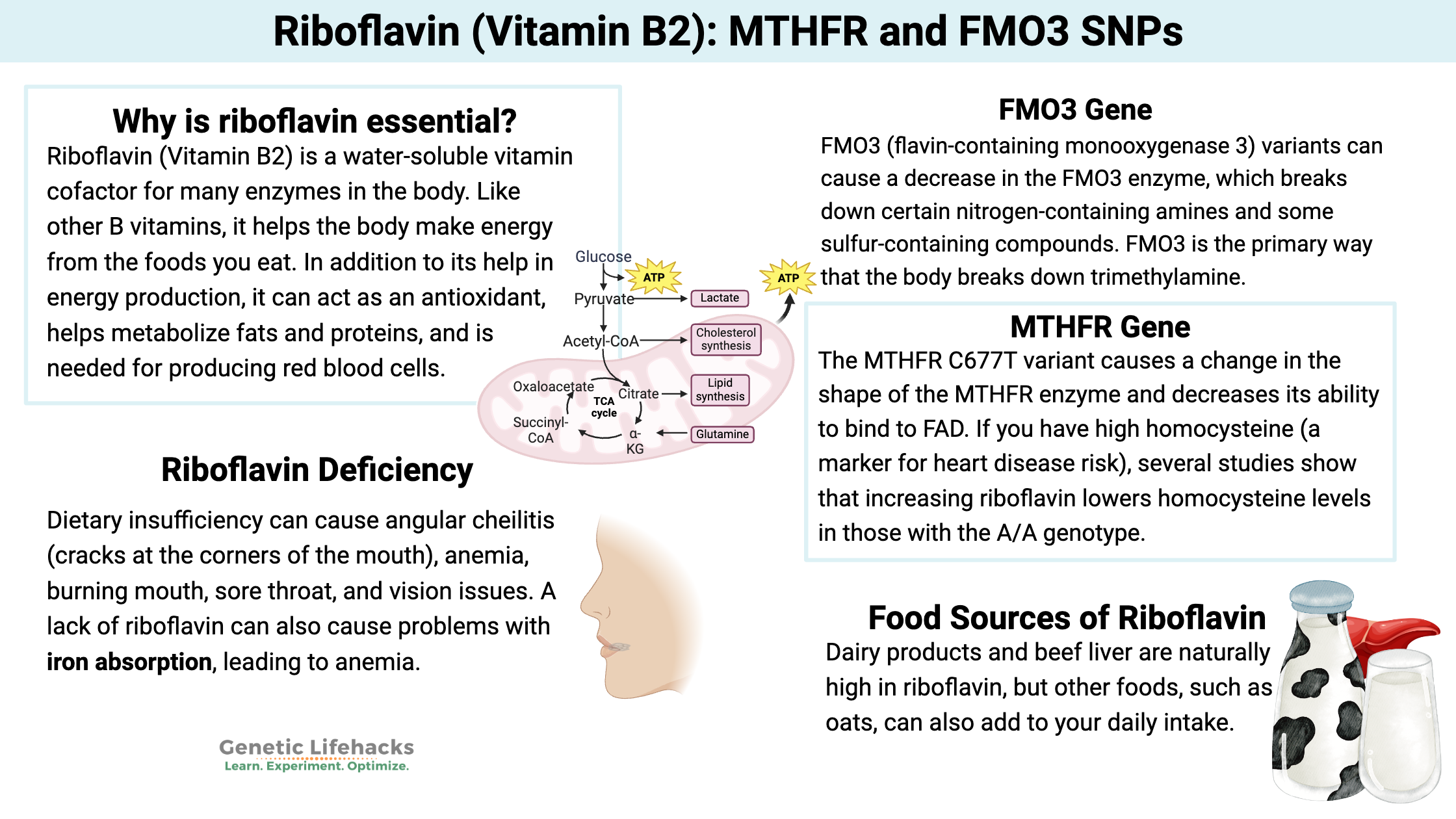Key takeaways:
~Riboflavin (Vitamin B2) is essential for energy production, acting as a coenzyme in numerous metabolic processes, including the metabolism of fats, proteins, and the formation of red blood cells.
~ Genetic variants in genes like MTHFR and FMO3 can increase riboflavin requirements, impacting processes such as homocysteine regulation and detoxification pathways.
~ Riboflavin deficiency may manifest as angular cheilitis, anemia, sore throat, and vision problems, particularly affecting the elderly, vegans, and individuals with certain health conditions.
Why is riboflavin essential?
Riboflavin (Vitamin B2) is a water-soluble vitamin cofactor for many enzymes in the body. Like other B vitamins, it helps the body make energy from the foods you eat. In addition to its help in energy production, it can act as an antioxidant, helps metabolize fats and proteins, and is needed for producing red blood cells.
Riboflavin is made up of a ribose sugar bound to a flavin molecule. It is the precursor to FMN (flavin mononucleotide) and FAD (flavin adenine dinucleotide), which are coenzymes involved in numerous vital functions in our bodies. FAD is essential to the electron transport chain, which is how your body produces energy in the mitochondria. FAD is also involved in detoxification as a cofactor for some CYP450 enzymes, as well as for glutathione recycling.[ref]
Riboflavin also helps convert tryptophan to niacin, which in turn helps the body with vitamin B6.[ref]
Riboflavin is found in dairy products, eggs, liver, enriched flour, and in minor amounts in other foods. The US RDA is 1.6mg for adults, and most people are estimated to meet this with their daily food consumption.
If you don’t eat dairy, eggs, or liver, you may want to track your daily riboflavin consumption for a few days to see if you are getting the normal amount. Cronometer is a free online app that is great for keeping track of nutrients.
Riboflavin is absorbed from foods as they are broken down in the upper part of the small intestines. Excess riboflavin, such as from supplements, is excreted out through the kidneys and makes your pee yellow.[ref]
What are the signs of riboflavin deficiency?
Dietary insufficiency can cause angular cheilitis (cracks at the corners of the mouth), anemia, burning mouth, sore throat, and vision issues. A lack of riboflavin can also cause problems with iron absorption, leading to anemia.
People more likely to suffer from riboflavin deficiency include the elderly, women on birth control, vegans, and alcoholics. Riboflavin is also being investigated and used for cataracts.[ref][ref]
Safety of supplementing:
There is no known toxicity for taking too much riboflavin, and there is no upper limit for vitamin B2 set in the US.[ref]
Riboflavin Genotype Report:
Several genetic variants can cause an increased need for riboflavin.
MTHFR gene:
The MTHFR codes for the enzyme needed to convert folate to methylfolate, a key component in the methylation cycle. The MTHFR C677T variant causes a change in the shape of the MTHFR enzyme and decreases its ability to bind to FAD.[ref] If you have high homocysteine (a marker for heart disease risk), several studies show that increasing riboflavin lowers homocysteine levels in those with the A/A genotype.[ref][ref] Other research points to riboflavin lowering homocysteine levels only if vitamin B6 levels are adequate.[ref]
Additional research shows that low riboflavin status in women with MTHFR C677T increases the risk of fractures in osteoporosis.[ref][ref]
For those with the A/A genotype and high blood pressure, riboflavin (1.6 mg/day) lowered systolic blood pressure by 5 – 13 mmHg. That is actually a pretty significant decrease from simply adding vitamin B2![ref]
Check your genetic data for rs1801133 (23andMe v4, v5; AncestryDNA):
- G/G: typical
- A/G: one copy of C677T allele (heterozygous), MTHFR efficiency reduced by 40%
- A/A: two copies of C677T (homozygous), MTHFR efficiency reduced by 70 – 80%
Members: Your genotype for rs1801133 is —.
FMO3 Gene:
FMO3 (flavin-containing monooxygenase 3) variants can cause a decrease in the FMO3 enzyme, which breaks down certain nitrogen-containing amines and some sulfur-containing compounds. FMO3 is the primary way that the body breaks down trimethylamine. Decreased FMO3 activity can cause an increase in trimethylamine, which causes a fishy-smelling body odor.[ref] Some people with mild FMO3 variants are helped with riboflavin.[ref]
These first four variants are more significant reductions in enzyme activity and are linked to TMAU (fish odor or strong body odor). Note that 23andMe doesn’t cover all the FMO3 variants that decrease the function.
Access this content:
An active subscription is required to access this content.
Related Articles and Topics:
MTR and MTRR Genes: Vitamin B12, Homocysteine, and Methylation
Debbie Moon is the founder of Genetic Lifehacks. Fascinated by the connections between genes, diet, and health, her goal is to help you understand how to apply genetics to your diet and lifestyle decisions. Debbie has a BS in engineering from Colorado School of Mines and an MSc in biological sciences from Clemson University. Debbie combines an engineering mindset with a biological systems approach to help you understand how genetic differences impact your optimal health.

